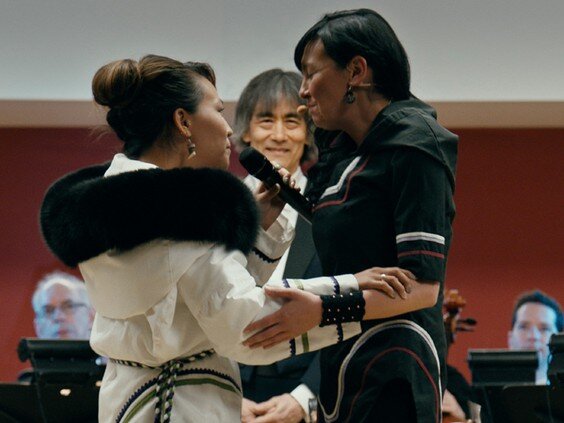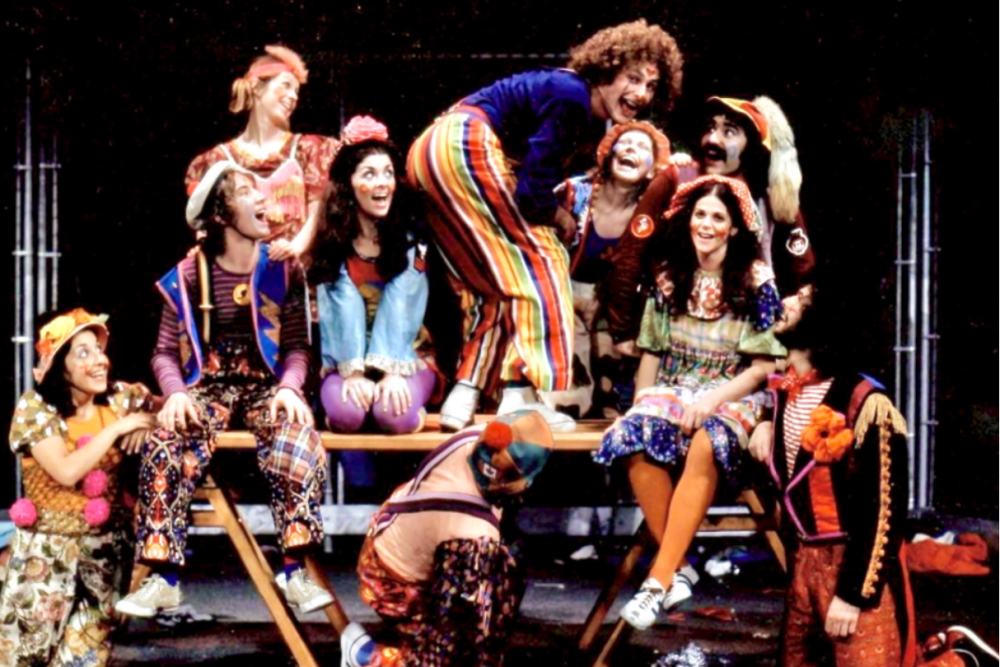Film review: Chaakapesh documentary follows symphony to the northern tundra, in attempt at reconciliation through art
Sharing and connection, as Cree, Innu, and Inuit communities help the Montreal Symphony Orchestra build new opera by Tomson Highway and BC’s Matthew Ricketts
Inuit throat singers perform for the Montreal Symphony Orchestra in the Far North.
Visions Ouest is streaming Chaakapesh for the month of June.
RELEASED ONLINE yesterday to mark National Indigenous People’s Day, Chaakapesh captures a lot of the complexity of the struggle toward reconciliation and decolonization through the arts.
Filmmakers Roger Frappier and Justin Kingsley take a detailed look at the Montreal Symphony Orchestra as it creates and tours the chamber opera Chaakapesh: The Trickster’s Quest, to mark its 85th anniversary in 2018. The work features a libretto from Tomson Highway and music by Victoria-born composer Matthew Ricketts, and maestro Kent Nagano eventually takes it on a road trip to the distant Indigenous communities of Quebec’s Far North.
Some of the film’s most moving scenes take place in the gymns and rec halls there, where Innu, Inuit, and Cree performers join the symphony and opera singers. Magic happens amid jungle gyms and basketball hoops, in settings full of small children, far removed from the tony concert halls of the south.
The opera itself, Chaakapesh: The Trickster’s Quest, is a bitingly funny take on an Innu story—a mix of the magical, the human, and the hilariously vulgar that could only be conjured by Highway, who is seen at one moment laughing it up with Inuit guides by a snow mobile. The opera follows a trickster asked by a god to to stop the massacre of his people by white settlers through teaching those colonists to laugh. In one interview, Highway gets a sizable kick out of what the Christian world might think of the gender-fluid god in the opera—“The scandal!”
The work’s unique challenges include parts sung in three languages: Innu, Cree, and Inuktitut. The significance of schoolchildren seeing their languages embraced and expressed on an operatic stage, in a country that once forbid those tongues, is profound. At one point, tenor Owen McCausland, much more used to Italian, talks about the unique experience of learning to sing in Cree.
Refreshingly, Japanese-American maestro Nagano (who’s fluent in French, adding another layer of language and identity here) has no illusions that the project will solve the world. In the early stages of the creation, he simply recognizes the need to change the way the symphony visits northern communities. Reflecting on the last tour a decade earlier, in which the orchestra played a Stravinsky work, he says, “The discussion has changed in Canada.”
Florent Vollant in Chaakapesh.
Collaborations bridging colonial and Indigenous art forms are sensitive ground; as one interviewee succinctly puts it, “There’s a difference between sharing and stealing.” But through curiosity, listening, and the generosity of its Indigenous artists, this project works beautifully. Ricketts is up front about the “improbable combination” of elements in the opera: “I’m a white guy from the city; he’s a Cree guy from the North,” he says of his librettist. But he stresses he’s loathe to impersonate Indigenous music; “I’m not trying to make a hybrid.”
The fragments of the opera you get here are mesmerizing, contemporary strains of the orchestra evoking the wind and animals of the North (Ricketts spent a residency with the team there), and then integrating throat singing and other solos by Indigenous performers and narrators.
The most moving scene in the film—especially given the recent discovery of mass graves in Kamloops—comes when well-known Innu singer Florent Vollant (one of the work’s three alternating narrators) recalls being taken away from his family at age five to spend seven years in the residential school system. “I discovered fear there,” he says, recalling the loss of the vastness of the land, replaced by desks, pencils, and rulers. By the time he emerged at 16, he felt part of him had been erased. But years of rediscovering his language and music helped him rebuild his life. One of his few enduring memories of childhood before residential school was a makushan, a family celebration with music and dancing, and he says he’s devoted his life to a quest to re-create the feeling he had then.
Music is what helped pull him out of that hole, and Chaakapesh offers a way for music to rebuild bridges. But Vallant’s insights are also a reminder, in an upbeat and optimistic film, that the road to reconciliation is still a long, hard one.














